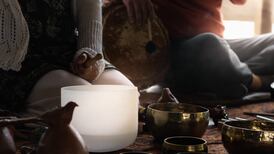The author Dervla Murphy is not the only travel writer closely associated with Lismore in Waterford. Another well-known member of that club linked to the town is the English writer Patrick Leigh Fermor who first visited in 1956.
Lismore Castle, complete with what Fermor described as its Rapunzel tower, and its surroundings, made a lasting impression on the writer who is best remembered for his tales of travel to far-off lands. His first great adventure led him on a year-long walk from Rotterdam to Istanbul at age 18.
Fermor was a friend of Lismore castle’s owners, Andrew Cavendish and his wife Deborah, who had the titles of Duke and Duchess of Devonshire. She was the youngest of the six Mitford sisters and was known to her friends as Debo.
She met Fermor (known as Paddy) at a party in 1940. He was a 25-year-old intelligence officer and she was 20, engaged to an army officer. They met again at parties in London in the 1950s and began corresponding in 1954.
Setting the Bar High – Frank McNally on pubs called The Irish Times (and more songs about newspapers)
The Times they are a-name-checking – Frank McNally on songs about newspapers
Lexicographer at Large – Frank McNally on Dinneen’s Dictionary and the Dáil row about unparliamentary Irish
For Whom the Bells Toll – Frank McNally on the ups and downs of “sound baths”
Around 600 of their letters survive. Some have made their way into edited books, shining a light on their friendship. They also provide an insight into their impressions of Lismore, and Ireland generally, during the second half of the 20th century.
Writing in May 1956 after his first visit, Fermor thanked his hosts for a “lovely Paradise stay in Lismore”.
He claimed that after the trip, he existed in a “glorious afterglow of it” and that whenever he thought of it, he found himself “smiling with the inane felicity of a turnip lantern”.
In a letter to a friend afterwards, Fermor enthused that Lismore was “beyond all expectations, absolute bliss throughout”. From his description, it seems to have taken on an other-worldly quality in his imagination.
He paints a vivid picture of the usually mundane flora and fauna that one would expect to see in such a setting. Petals from a magnolia tree fell like giant snowflakes. Trees so overgrown with lichen took on the appearance of green coral. This, together with drooping ferns and lianas, prompted Fermor to say that it almost had the appearance of an equatorial jungle.
He explained that the castle and the “primeval forest round it were spellbound in a late spring or early summer trance”. He noted that there was a heavy rhododendron blossom everywhere and likened the river Blackwater, which runs alongside the castle and gardens, to the Limpopo river in Africa.
Days were spent travelling around the neighbourhood, smelling gorse burn, visiting cows, observing salmon being hauled in at Dromana, and drinking Guinness as they went on their odyssey. Trips were also arranged to Helvick and Ardmore.
On a later holiday, he tells of visits to the Lismore wine vaults and a “sawdust scattered drinking hell” in the town with Andrew.
His initial positive reaction to Lismore does not seem to have dimmed with the passing of time.
After a visit in April 1984, almost 30 years after his first visit, he declared that he was still “living in the afterglow of those lovely days at Lismore”. He admitted that it was “more marvellous than ever, even than that glorious first sojourn”.
As much as it was an appreciation of Lismore, it seems that it was the human connection that Paddy savoured during his trips there. He enjoyed meeting the family, who seemed to him like “saints and angels in human form”, horse riding, the outings and the “fun, jokes and everything”.
It was also the simpler things that appealed to him at Lismore such as watching a sunset stream through tree branches on a walk through the wood above the river before dinner on his last day. A meeting with a woman who lived in a cottage in the wood, and who gave them tea and Guinness and currant buns, stayed in his memory.
On his departure from Lismore, he felt that he was an “exile wandering far away from Eden”. Their friendship lasted for decades and has been described as a “platonic attraction” between two people known for their “youthful high spirits, warmth, generosity and an unstinting enjoyment of life”.
Paddy was an avid letter writer and penned somewhere between 5,000 and 10,000 letters in his lifetime. Apart from the residents of Lismore castle, he had other correspondents in Ireland.
He wrote to Enrica (Ricki) Huston, wife of John Huston, at St Clerans near Craughwell in Galway. Letters recount tales of his visits to Birr, Luggala, and other global adventures. She was the person who rescued him after he got into a brawl at a hunt ball in Kildare at 3am after having imbibed too much.
It’s not clear if he would have had enough material for a book on Ireland but it would certainly have made for interesting reading if he did.















